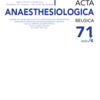PONV prophylaxis after laparoscopic procedures - Comparison between Palonosetron 0.075mg, Palonosetron 0.15mg and a Palonosetron-Dexamethasone combination : a randomised controlled trial
Published online: Mar 30 2020
Abstract
Background : Postoperative nausea and vomiting (PONV) is one of the common complications after surgery. This randomized double-blind study was planned to compare the effectiveness of different antiemetic regimens for PONV prophylaxis in moderately high-risk patients.
Methods : One hundred and sixty adult ASA grade I-II female patients undergoing day care gynecological laparoscopic procedures were randomly allocated into four groups. Group 1 patients (Control group) received 4 mg ondansetron, group 2 (P75 group) patients received 0.075 mg palonosetron, group 3 (P150 group) patients received 0.150 mg palonosetron, and group 4 (PD group) patients received 0.075 mg palonosetron and 8 mg dexamethasone after induction of anesthesia. Anesthesia was induced with propofol and fentanyl, and maintained with N2O-isoflurane in oxygen. The number of complete responders, frequency of nausea and vomiting episodes and the requirement of rescue antiemetic during 0-6 h, 6-24 h and 24-72 h after surgery were recorded.
Results : Patients receiving dexamethasone and palonosetron combination had significantly less vomiting (p = 0.03) and required less rescue antiemetic as compared to Control group (p = 0.014). The incidence of nausea was low in all palonosetron groups as compared to the ondansetron group. The complete response rate was significantly high in the PD group as compared to other groups (p = 0.012). There was no significant difference in nausea and vomiting in patients receiving palonosetron 0.075 mg or 0.15 mg.
Conclusions : We conclude that a dexamethasone-palonosetron combination is more effective than ondansetron and palonosetron alone for the prevention of PONV, while palonosetron 0.150 mg has no significant benefit over 0.075 mg for PONV prophylaxis in moderately high-risk patients.
